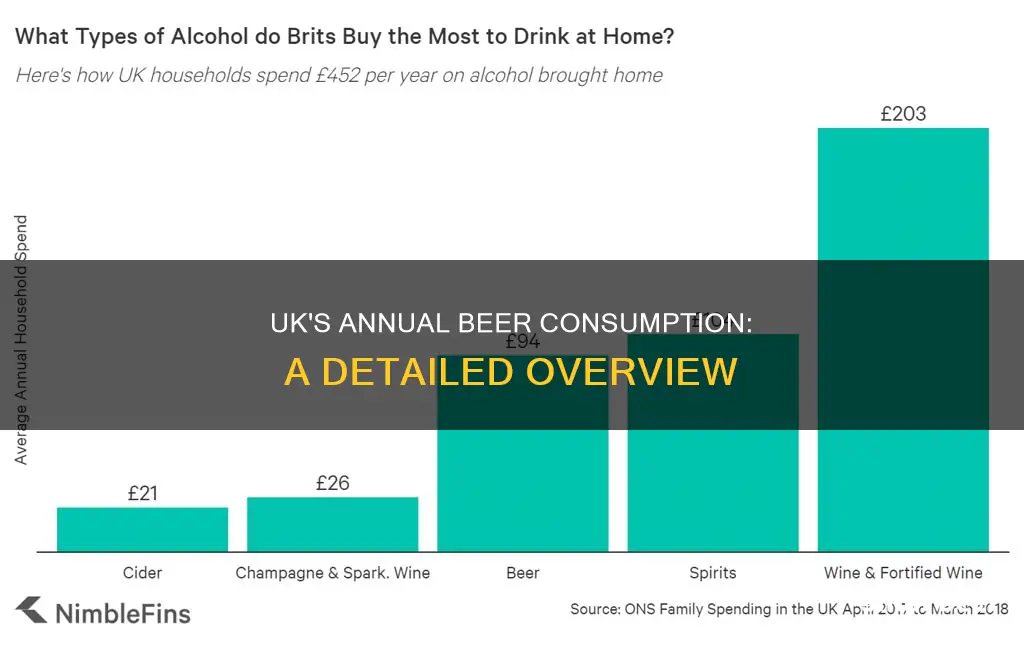
Alcohol consumption in the UK has been a dynamic issue, with drinking behaviours changing over time and in response to societal shifts. While the UK's alcohol consumption rates are average among European countries, it consistently ranks the highest for its binge-drinking culture. In 2017, an estimated 29 million people in the UK drank alcohol, with consumption rates varying across different demographic groups. Beer, a long-time favourite in Britain, has seen its market domination decrease since the 1960s, with wine and cider gaining popularity. In 2018, beer consumption rebounded to become the most consumed alcoholic beverage in the UK, with 8.5 billion pints sold.
| Characteristics | Values |
|---|---|
| Volume of beer consumed per capita in 2020 | 61 litres |
| Volume of beer consumed per capita in 2021-2022 | 68 litres |
| Average consumption per adult | 9.7 litres of pure alcohol per year |
| Average consumption per adult | 18 units a week |
| Average spend on alcohol per person per week in 2020 | £7.43 |
| Average volume of beer/lager purchased per person per week in 2021/22 | 496-609ml |
| Average volume of cider purchased per person per week in 2021/22 | 82-93ml |
| Average volume of spirits purchased per person per week in 2021/22 | 70-75ml |
| Average volume of wine purchased per person per week in 2021/22 | 201-251ml |
| Average number of units consumed by men aged 65-74 in England in 2022 | 21.4 |
| Average number of units consumed by women aged 65-74 in England in 2022 | 10 |
What You'll Learn

Beer consumption per capita in the UK
Drinking patterns vary across different social groups. For instance, older people are more likely to drink regularly, and men are more prone to binge drinking than women, although this gender gap narrows among younger drinkers. Higher earners also tend to drink more than those with lower incomes. Notably, a small group of heavy drinkers, constituting only 4% of the population, consumes about 30% of the UK's total alcohol sales.
The UK's drinking culture has evolved over time, with wine consumption increasing since the 1960s and gaining dominance over beer in the 1980s. Beer consumption patterns also vary across the country, with regions like the North East, North West, and South West exhibiting higher consumption levels than London and the South East.
While alcohol consumption rates in the UK are average compared to other European countries, the UK consistently ranks the highest for its binge-drinking culture. Binge drinking, defined as consuming 6 or more units of alcohol for women and 8 or more units for men in a single session, has severe economic implications, costing the UK economy approximately £20 billion annually.
To address excessive drinking and promote healthier habits, the UK Chief Medical Officer recommends drinking no more than 14 units of alcohol per week, equivalent to about 6 pints of beer.
Beer and Collagen: Is It Safe to Mix?
You may want to see also

Beer sales in the UK
Beer has a long history in the UK, dating back to the 8th century when the consumption of alcoholic beverages became a staple part of the British diet, particularly among manual workers. British pub culture also has Roman origins, combining northern European traditions of heavy episodic drinking with social drinking within bars. Despite attempts by various groups to prohibit alcohol consumption and legislation such as the Sale of Beer Act 1854, which restricted Sunday opening hours, the sale and consumption of alcohol have never been illegal in the UK.
In recent years, the UK's drinking culture has evolved, with wine sales increasing due to expanding global trade, falling prices, and wider availability in supermarkets. As a result, wine has largely replaced beer as the most consumed alcoholic drink within the home. However, beer remains a popular choice, especially in pubs and licensed premises.
While drinking behaviours vary across the country, with regions like the North East, North West, and South West exhibiting higher consumption levels than London and the South East, the UK consistently ranks among the highest for binge drinking culture. Binge drinking costs the UK economy approximately £20 billion per year, with an estimated 17 million working days lost due to hangovers and drink-related illnesses.
Looking at consumption per capita, the average consumption in the UK was about 9.7 litres of pure alcohol per year or about 18 units per week. Men tend to consume more alcohol than women, with 55%-57% of men drinking at least once a week compared to 40%-43% of women. However, among younger drinkers, the amounts consumed and the prevalence of binge drinking are similar between genders, with some cases showing higher consumption among young women.
The Science Behind Beer Koozies: Do They Really Work?
You may want to see also

Beer consumption by age and gender
Beer consumption in the UK varies by age and gender. While men are more likely to binge drink than women, the difference between genders has narrowed in recent years, with younger women drinking similar amounts to their male counterparts and, in some cases, surpassing them.
In 2022, 55% of men drank at least once a week compared to 42% of women, and 8% of men reported drinking almost daily compared to 5% of women. The proportion of adults who drink at least once a week has declined from 54% to 48% between 2011 and 2022.
When looking at age, adults aged between 65 and 74 drank the most, with men in this age group consuming on average 21.4 units of alcohol per week, and women drinking on average 10 units per week. The lowest prevalence of drinking was found in adults aged between 16 and 24, with 60% drinking at least once a week.
While youth drinking has been falling steadily, consumption among older people has not changed at the same rate. People aged 55-64 are more likely than any other age group to drink at higher-risk levels and are the least likely to abstain from alcohol.
Beer and Piles: A Risky Combination?
You may want to see also

Beer consumption by region
Beer consumption in the UK has been declining since the mid-2000s, with an average consumption per adult of 9.7 litres of pure alcohol per year, or about 18 units a week. This decline is especially prominent among young people, with around 20% of the population not drinking at all. Drinking behaviours are influenced by shifts in social attitudes, marketing, and legislation, resulting in variations across different social groups and regions.
When examining beer consumption by region, notable differences emerge. Scotland consistently exhibits higher consumption levels than England, attributed to the availability of cheap alcohol in off-licences. Within England, the North East, North West, and South West regions have higher consumption levels than London and the South East. These regional disparities underscore the dynamic nature of drinking behaviours in the UK, influenced by factors such as affordability, availability, and cultural attitudes toward alcohol.
While overall consumption has decreased, certain demographic groups stand out. Older individuals, particularly those aged 55-64, are more likely to drink at higher-risk levels and are the least likely to abstain from alcohol. Men are more prone to binge drinking than women, although this gender gap narrows among younger drinkers, with similar consumption levels observed. Higher earners and those from older age groups are more likely to drink regularly.
The UK's drinking culture has evolved, and the types of beverages consumed have also shifted. Initially, most alcohol consumption in the 1970s consisted of beer enjoyed in pubs. However, the expansion of the global wine trade, coupled with increasing wine sales and availability in supermarkets, has led to a significant increase in wine consumption, primarily at home.
Japanese Beer Drinkers: How Do They Stay Slim?
You may want to see also

Beer affordability
The price of alcohol has gradually become more affordable over time on a per capita basis. This price varies from location to location in the UK. In London, the average price of a pint is £5.20, while across the UK as a whole, it is £3.50. The average spend on alcohol per person per week in 2020 was £7.43 across the entire UK, which was 10% higher than in 2017.
In 2021/22, the average spend on alcohol per person per week was £6.08, which declined from £6.42 in 2015/16. On average, each person spent £3.89 on alcohol for the household each week compared to £2.19 for consumption outside the home. Weekly spend on alcohol for the household increased from £3.18 to £3.89 between 2015/16 and 2021/22. Weekly spend on alcohol for consumption outside the home declined from £3.24 to £2.19 between 2015/16 and 2021/22.
In 2022, 57% of adults (aged 16+) drank up to 14 units each week, and 24% drank more than 14 units. 32% of men drank more than 14 units each week compared to 15% of women. The highest prevalence of drinking more than 14 units each week was among adults aged between 55 and 64, whereas the lowest was among adults aged between 16 and 34 (30% vs 19%).
The UK Chief Medical Officer's low-risk drinking guidelines recommend drinking no more than 14 units per week. This is the equivalent of 6 glasses of wine or 6 pints of beer.
Drinking Beer in Public: What's the Legal Limit?
You may want to see also
Frequently asked questions
The volume of beer consumed per capita in the UK has been decreasing since 2008. In 2020, consumption declined to 61 litres per capita before rebounding to 68 litres in 2021, 2022 and 2023.
The average consumption per adult in the UK is about 9.7 litres of pure alcohol per year, or about 18 units a week.
In 2022, 48% of adults (aged 16+) drank alcohol on at least one day each week. This equates to around 29 million people.
In 2020, the average spend on alcohol per person per week was £7.43 across the entire UK.
Around 20% of the UK population do not drink alcohol. This figure is increasing, especially among young people.







